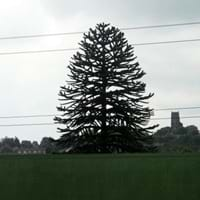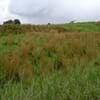Life Span
Perennial
Perennial
Type
Grass
Needled or Scaled Evergreen
Origin
United States, Northeastern United States, Mid-Atlantic United States, Southeastern United States, North-Central United States, Central United States, South-Central United States, Texas
Argentina, Chile
Types
Virginia water horehound
not available
Habitat
Along Railroads, Barren waste areas, Hill prairies, Mined land, Pastures, Roadsides, Rocky glades, Sandy areas, Upland, Upland clay prairies, Upland sand prairies, Upland sandy savannas, Upland savannas, Upland soils
Subtropical forests
USDA Hardiness Zone
5-8
7-11
Sunset Zone
Not Available
H1, H2, 4, 5, 6, 7, 8, 9, 14, 15, 16, 17, 18, 19, 20, 21, 22, 23, 24
Habit
Clump-Forming
Oval or Rounded
Minimum Width
Not Available
Flower Color
Not Available
Green
Flower Color Modifier
Bicolor
Bicolor
Fruit Color
Not Available
Green
Leaf Color in Spring
Green
Green, Dark Green
Leaf Color in Summer
Light Green
Dark Green
Leaf Color in Fall
Orange, Tan, Brown
Dark Green
Leaf Color in Winter
Tan, Sandy Brown
Dark Green
Leaf Shape
Grass like
Needle like
Plant Season
Summer, Fall, Winter
Spring, Summer, Fall, Winter
Sunlight
Full Sun, Partial Sun, Partial shade
Full Sun, Partial Sun
Type of Soil
Loam, Sand
Clay, Loam, Sand
The pH of Soil
Acidic, Neutral, Alkaline
Acidic, Neutral, Alkaline
Soil Drainage
Well drained
Well drained
Bloom Time
Early Fall, Fall
Not Available
Tolerances
Pollution, Drought
Drought
Where to Plant?
Ground
Ground, Pot
How to Plant?
Divison, Root Division, Seedlings
Tip cutting
Plant Maintenance
Medium
Medium
Watering Requirements
Average Water Needs, Medium
Allow to dry out slightly between watering
In Summer
Lots of watering
Lots of watering
In Spring
Moderate
Moderate
In Winter
Average Water
Average Water
Soil pH
Acidic, Neutral, Alkaline
Acidic, Neutral, Alkaline
Soil Type
Loam, Sand
Clay, Loam, Sand
Soil Drainage Capacity
Well drained
Well drained
Sun Exposure
Full Sun, Partial Sun, Partial shade
Full Sun, Partial Sun
Pruning
Remove damaged leaves, Remove dead branches, Remove dead leaves
Remove damaged leaves, Remove dead branches, Remove dead leaves
Fertilizers
All-Purpose Liquid Fertilizer
All-Purpose Liquid Fertilizer
Pests and Diseases
Red blotch
Anthracnose, Branch Droop, Root rot, Yellow Leaves
Plant Tolerance
Drought
Drought
Flowers
Insignificant
Insignificant
Flower Petal Number
Single
Single
Fragrant Bark/Stem
No
Yes
Foliage Texture
Fine
Fine
Foliage Sheen
Matte
Glossy
Attracts
Birds, Butterflies
Not Available
Allergy
Pollen
Not Available
Aesthetic Uses
Not Used For Aesthetic Purpose
Showy Purposes, Used as Christmas tree
Beauty Benefits
Not Available
Not Available
Edible Uses
Insignificant
No
Environmental Uses
Air purification, Food for birds, Wildlife
Air purification
Medicinal Uses
Back pain, Diarrhea, Frostbite, Itching, Piles, Sore Eyes, Sore throat
Not Available
Part of Plant Used
Root, Seeds, Stem
Whole plant
Other Uses
Cattle Fodder, Used As Food, Used as Ornamental plant
Used in Furniture, Useful for shade
Used As Indoor Plant
No
Yes
Used As Outdoor Plant
Yes
Yes
Garden Design
Dried Flower/Everlasting, Wildflower
Container, Feature Plant
Botanical Name
ANDROPOGON virginicus
ARAUCARIA araucana
Common Name
Broomsedge, Broomsedge Bluestem
Monkey Tail Tree, Chilean Pine, Pehuén
In Hindi
Broomsedge grass
Monkey Puzzle Tree
In German
broomsedge Gras
Chilenische Araukarie
In French
broomsedge herbe
Araucaria du Chili
In Spanish
hierba Broomsedge
araucaria o pehuén
In Greek
Broomsedge γρασίδι
Monkey Puzzle Tree
In Portuguese
Broomsedge grama
Monkey Puzzle Tree
In Polish
Broomsedge trawy
Araukaria chilijska
In Latin
Broomsedge herba
Monkey Puzzle Tree
Phylum
Magnoliophyta
Pinophyta
Class
Liliopsida
Pinopsida
Family
Poaceae
Araucariaceae
Genus
Andropogon
Araucaria
Clade
Angiosperms, Commelinids, Monocots
Not Available
Tribe
Andropogoneae
Not Available
Subfamily
Panicoideae
Not Available
Number of Species
Not Available
Not Available
Season and Care of Broomsedge and Monkey Puzzle Tree
Season and care of Broomsedge and Monkey Puzzle Tree is important to know. While considering everything about Broomsedge and Monkey Puzzle Tree Care, growing season is an essential factor. Broomsedge season is Summer, Fall and Winter and Monkey Puzzle Tree season is Summer, Fall and Winter. The type of soil for Broomsedge is Loam, Sand and for Monkey Puzzle Tree is Clay, Loam, Sand while the PH of soil for Broomsedge is Acidic, Neutral, Alkaline and for Monkey Puzzle Tree is Acidic, Neutral, Alkaline.
Broomsedge and Monkey Puzzle Tree Physical Information
Broomsedge and Monkey Puzzle Tree physical information is very important for comparison. Broomsedge height is 60.96 cm and width 30.48 cm whereas Monkey Puzzle Tree height is 1,520.00 cm and width Not Available. The color specification of Broomsedge and Monkey Puzzle Tree are as follows:
Broomsedge flower color: Not Available
Broomsedge leaf color: Green
Monkey Puzzle Tree flower color: Green
- Monkey Puzzle Tree leaf color: Green and Dark Green
Care of Broomsedge and Monkey Puzzle Tree
Care of Broomsedge and Monkey Puzzle Tree include pruning, fertilizers, watering etc. Broomsedge pruning is done Remove damaged leaves, Remove dead branches and Remove dead leaves and Monkey Puzzle Tree pruning is done Remove damaged leaves, Remove dead branches and Remove dead leaves. In summer Broomsedge needs Lots of watering and in winter, it needs Average Water. Whereas, in summer Monkey Puzzle Tree needs Lots of watering and in winter, it needs Average Water.





